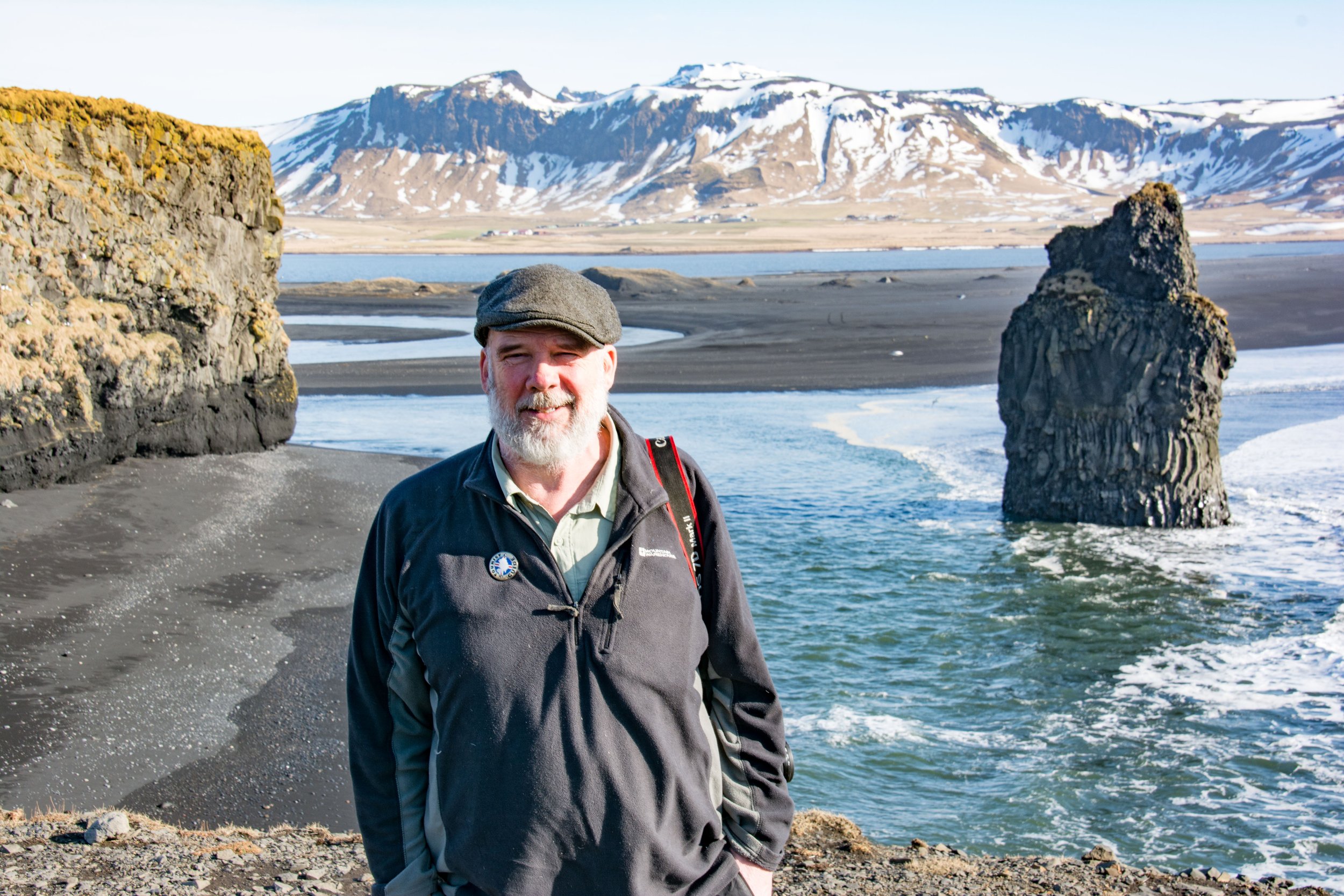Travel Guide to Thingvellir National Park, Iceland
Thingvellir National Park is a symbol of Iceland's birth as a nation. While it may appear to be just a grassy field at the edge of a lake with some impressive cliffs, this landscape of fissures and moss-covered lava holds immense historical and geological significance.
Historically, Thingvellir is where Iceland's settlers first gathered to establish the Althing, Iceland’s Parliament, in the year 930. From that point onward, Thingvellir was the major seat of Iceland’s democratic government. Viking chieftains traveled from across the country to meet, trade, settle feuds, and make deals with one another.
Geologically, Thingvellir is where the Mid-Atlantic fault line rises above the surface of the country. This visible feature allows visitors to get an idea of the powerful forces at play beneath Iceland, as its these tectonic plate movements that are behind so much of Iceland’s volcanic activity and spectacular landscapes.
There’s also something poetic about the idea that Iceland, marooned halfway between Europe and America and influenced by both sides of the pond, had its parliament meet at the literal edge of these two continents throughout its history.
Table of Contents
See more of our Iceland articles:


Why visit
Travelers in Iceland should visit Thingvellir National Park for several reasons. Firstly, it is arguably the most important historical location in the country. As the site where Iceland’s first settlers gathered to establish their Parliament, the Althing, it marks the birthplace of the world’s oldest continuing democracy. This makes Thingvellir a crucial destination for those interested in the rich history and culture of Iceland.
Secondly, Thingvellir offers some beautiful natural scenery. The large lake is beautiful, surrounded by a low-lying set of bumpy hills, and the area of fissures are fed with some of the clearest water imaginable, originating from the glaciers and fed underneath lava fields for hundreds of miles before emerging in the area.
The landscape isn’t the most dramatic of places in Iceland but offers more of a contemplative beauty. Wander away from the main areas of the park and that only deepens as you discover a field full of lava and secretive fissures (stick to the paths!).
Finally, visiting Thingvellir makes a lot of sense on a day tour of the Golden Circle. At just 45 minutes from Reykjavik, it’s a nice and easy stop to make before continuing to the erupting Geysir and waterfall Gullfoss.
But that’s not the only reason this is often the first destinations people visit after leaving Reykjavik; Thingvellir National Park is simply essential for understanding Iceland as a nation.
Where is Thingvellir National Park?
Thingvellir National Park is in South Iceland, approximately 45 minutes away from Reykjavik. This region, northeast of the capital city, is part of the famous Golden Circle, one of the most popular areas for day trips in Iceland.
Due to its proximity to Reykjavik, Iceland’s capital acts as an easy gateway to Thingvellir National Park.
Best time to visit
Thingvellir seen from the information center. Photo:Ivan Sabljak, CC BY-SA 3.0, via Wikimedia Commons
In my opinion, the best time to visit Thingvellir National Park is in May or June. During this period, spring is in full swing, the flora blooms brilliantly after the snow has melted, and daylight hours are long. The long days are especially appealing as they allow you to enjoy extended exploration in the park late at night, avoiding the major crowds that flock here during the day year-round.
Also, while May and June are by no means quiet here, the park is much less busy than during the summer months of July, August, and early September.
Visiting in Summer
July and August are the busiest times at Thingvellir. The park sees a significant influx of visitors due to its proximity to Reykjavik. While the weather is warm and the days are long, the thick crowds can make it challenging to fully appreciate the park's serene beauty.
Either arrive early in the morning (before 8:00 AM) or after dinner to avoid the tour buses from Reykjavik.
Visiting in Autumn
September and October offer a quieter experience at Thingvellir and are also a nice time to visit. The autumn colors transform the mossy lava fields into beautiful hues of red, orange, and yellow, contrasting beautifully with the often moody, grey skies. It’s peaceful, but there’s a high chance of rain as well.
Visiting in Winter
Winter, from November to February, lets you see a different to Thingvellir. The park is often covered in snow, creating a magical winter wonderland. While the temperatures are cold and daylight hours are short, the chance to see the Northern Lights makes it a unique and unforgettable experience.
Amazingly, the Silfra Fissure remains the same temperature, meaning you can still join a snorkeling or diving tour at this time.
Visiting in Spring
March and April mark the beginning of spring at Thingvellir. The snow begins to melt, and the park starts to come alive with new growth. The weather can be unpredictable, with a mix of rain and sunshine, but fewer people and emerging greenery make it a pleasant time to visit.
How long to spend in the park
In general, visitors only need two to three hours in Thingvellir National Park to explore the main attractions. This gives you enough time to browse the exhibition inside the Visitor’s Center, enjoy the views over the lake, and walk through the Mid-Atlantic Ridge, which leads you to several points of interest along the way.
Here’s how I’d recommend spending your time here:
Park at the main visitor’s center, ducking into the exhibition (paid) inside for a brief overview of the history of Thingvellir in about 30 to 45 minutes. Then, head outside to the Hakið viewpoint, which looks over the lake, the fissures, and the church on the plains below.
From here, it’s about a 30-minute walk to Öxarárfoss waterfall. Along the way, you’ll pass the Lögberg (Law Rock), where the Parliament passed their laws, and Drekkingarhylur (The Drowning Pool), where women were drowned for having children out of wedlock or committing crimes of incest.
Once you’ve taken in the waterfall, start backtracking the way you came. Veer off towards the river, where you’ll wander between the gorges and fissures of the park. First, cross over to Öxarárhólmi, an island in the middle of the river and the official site where Viking duels took place.
On the opposite bank there are several fissures to admire before heading down to the Thingvellir Church, built on the same spot as the original church that was constructed when the Althing decided to adopt Christianity in the year 1000.
Moving on, it’s just a short walk to the meeting point of the Silfra diving and snorkeling tours – highly recommended if you’re after one of the most unique experiences one can have in Iceland.
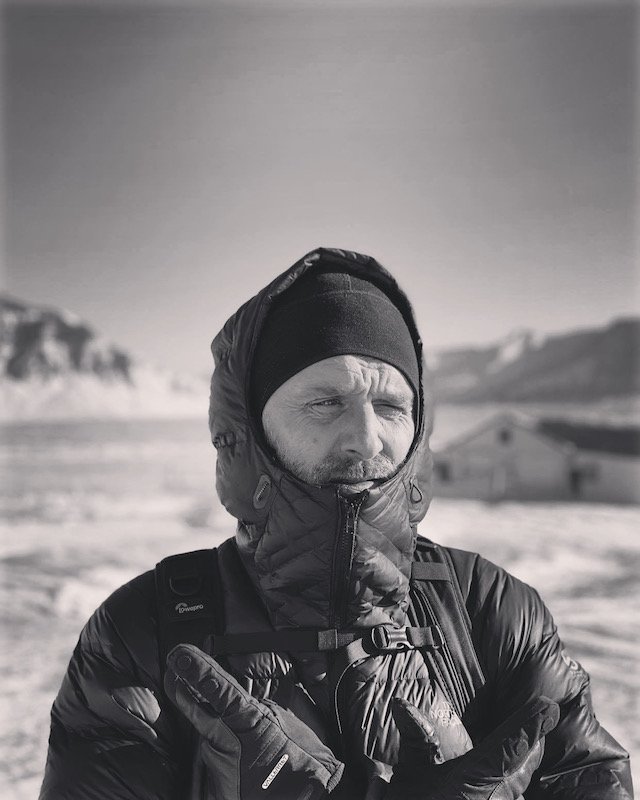
Connect with a local expert in Iceland for help perfecting your itinerary, answers to all your travel questions, and fabulous local tips for a better visit!
Where to stay in/around the national park
If you’re looking to explore Thingvellir on a deeper level for a whole day or more, or if you fancy hanging around for a showing of the northern lights, there are plenty of convenient options for an overnight stay:
Campsites
The National Park operates several campsites within Thingvellir. The Nyrðri-Leirar campground, located near the national park service center, welcomes visitors throughout the year. On the other side of the road is Syðri-Leirar campsite, which is open only in the summer. Both campsites can accommodate tents, campervans, and RVs.
Other campsites in Thingvellir are Vatnskot, Fagrabrekka, and Hvannabrekka. These three are only open during the summer and are designated for tent camping only.
Along the shores of Lake Thingvallavatn
The western side of Lake Thingvallavatn has a variety of accommodation options, from small guesthouses to collections of summer houses (the name Icelanders give to their small holiday homes). To the southwest, the popular ION Adventure Hotel offers a luxury stay very close to the national park, with a tempting outdoor geothermal pool and classy restaurant.
Laugarvatn
Laugarvatn is the closest town to Thingvellir, about 30 minutes to the east. It’s a small, peaceful spot on a lake, with several different options for accommodation. Also here is the Laugarvatn Fontana Spa, a quiet hot spring complex where you can also see them bake their own bread in the ground using the geothermal power.
Selfoss
45 minutes to the south on the ring road is Selfoss, one of the larger towns in Iceland. It’s a good base for exploration into the Golden Circle area and Thingvellir, with easy access to the south coast as well.
Reykjavik
Reykjavik, the capital city of Iceland, is about 45 minutes from Thingvellir National Park. It obviously has a wide range of accommodation options and all the conveniences of a city. Staying here lets you explore Thingvellir on a day trip and be back in time for dinner at a restaurant.
Logistics of Visiting Thingvellir National Park
Opening hours and accessibility
Thingvellir National Park is open 24/7, 365 days a year, like most places in Iceland. However, accessibility can vary with the seasons. In winter, it can be challenging if you stray from the main path between the Visitor’s Center and Öxarárfoss Waterfall due to snow and ice. Despite this, Silfra snorkeling and diving tours are available year-round.
Entrance points and parking areas/fees
From Reykjavik, it's a 45-minute drive to Thingvellir National Park along route 36. There is no entrance fee for Thingvellir National Park, however, you will need to pay for parking in any of the designated parking areas (listed below). Payments can be made online using the Parka App.
P1 – Thingvellir Visitor Center Parking – 1000 ISK
Located adjacent to the main Visitor Center and the Hakið viewing platform, this parking area serves as the main entrance into Thingvellir National Park. It’s where you’ll find the main exhibit inside the Visitor Center, a small store selling souvenirs, snacks, maps, and public bathrooms.
P2 – Öxarárfoss Waterfall Parking – 1000 ISK
Situated on the eastern side of the fissure, this secluded parking area is accessed via road 361 from the Service Center. It offers a peaceful retreat for visitors seeking swift access to the breathtaking Öxarárfoss waterfall. There are also public bathrooms here.
P3 – Öxarárfoss Trailhead Parking – Free
Located directly off Route 36 and about halfway between the Visitor Center and the Service Center, this sneaky parking area avoids the parking fees (so far) and provides backdoor access to the Mid Atlantic Ridge. From here, you’ll walk down into the park, approaching Öxarárfoss Waterfall from the north. There are no public bathrooms.
P5 – Silfra Fissure Parking – 1000 ISK
Note that there’s no P4 parking area, it jumps right ahead to P5. This is located south of Thingvallabær and the Thingvellir Church, and a few minutes’ walk away from the meeting point for the snorkeling and diving tours into the Silfra Fissure. There are also public bathrooms here.
The Visitor's Center
The main Visitor’s Center provides information, maps, and a permanent exhibit about the park's history and geology. For most people, this is the best starting point for visiting Thingvellir. There’s also a small shop selling souvenirs and other goodies.
Park Service Center
Located north of the lake on the bend, the Thingvellir Service Center includes the park's campsites and a small café. From here, you can walk across the road into the main area of the national park and explore the more remote northern territory.
Self-visit or better to go with a guide?
Both self-guided and guided tours are decent ways to explore the park. I’ve only ever been there by myself, learning about the historical significance through my own readings and research. But with a guide, you can glean some key insights and historical tidbits that only Icelandic guides might now.
On the other hand, guided tours to Thingvellir will likely only be included on a day tour of the Golden Circle – meaning you’ll only get at most an hour and a half before you’re hustled onto the bus to continue to Geysir. Self-guided visits allow you to explore at your own pace and spend more time at each site.
Restaurants, shops, and other facilities
The Service Center has a small café where you can grab a bite to eat. The main Visitor’s Center features a shop selling souvenirs and hiking maps. Both centers provide essential facilities, including bathrooms and information points. There are also public bathrooms at the P2 and P5 parking areas.
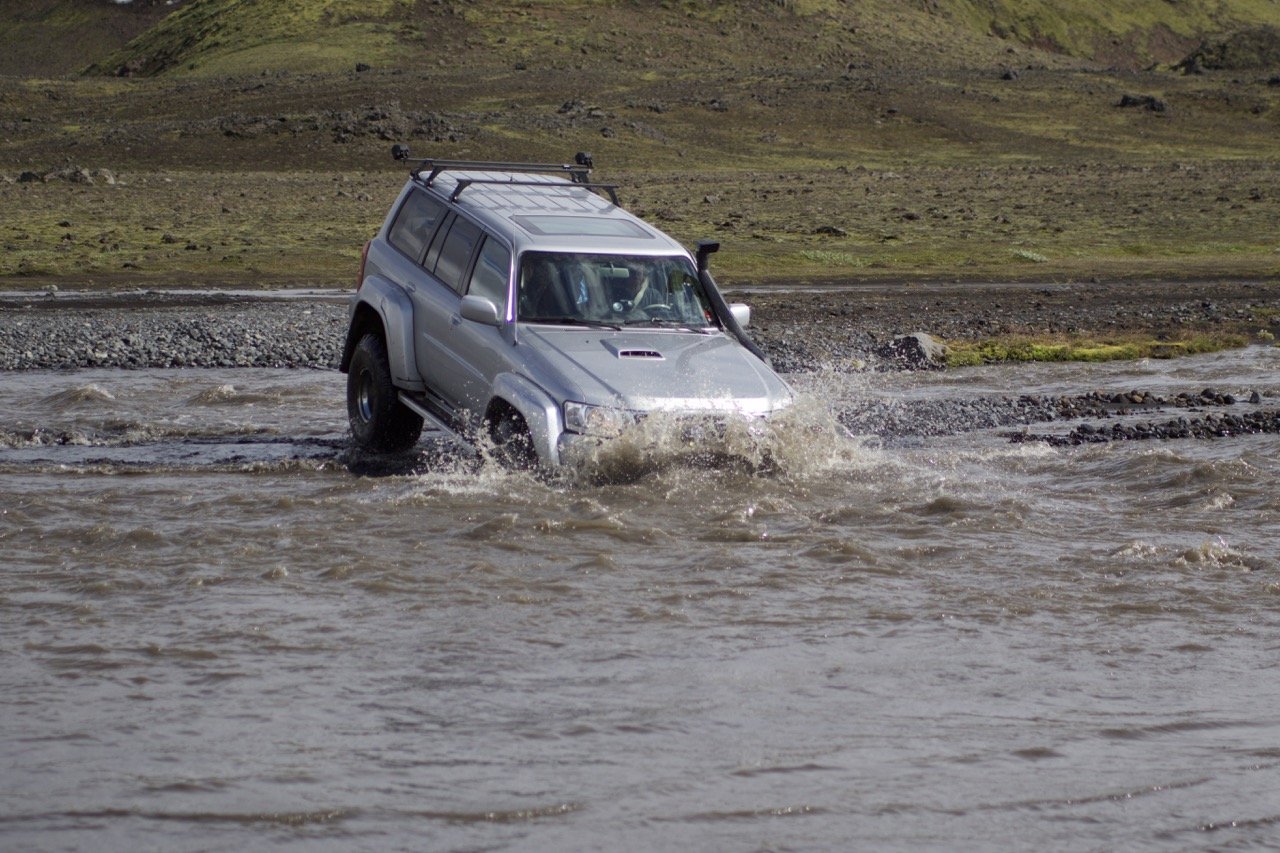
Areas of the park to visit

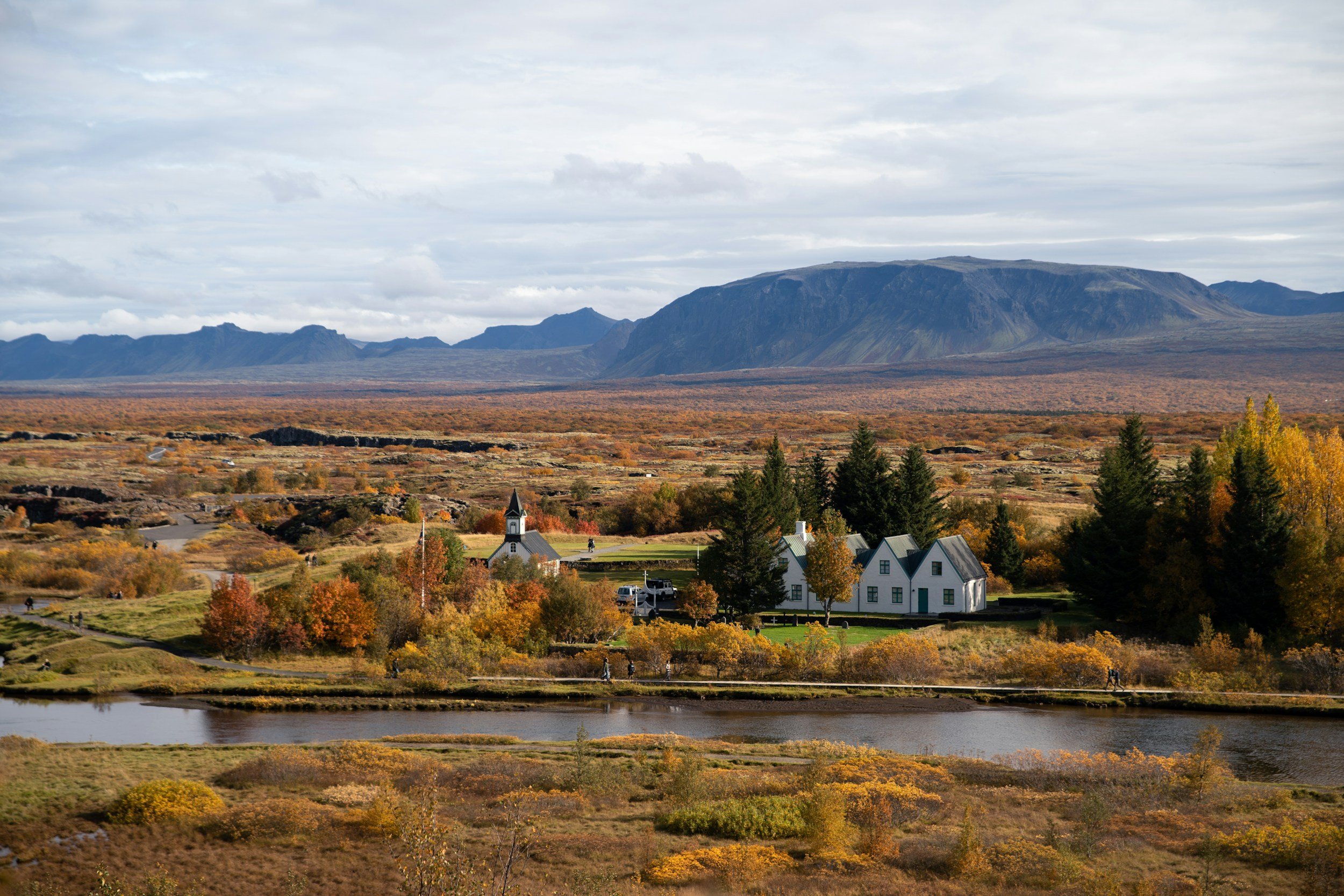

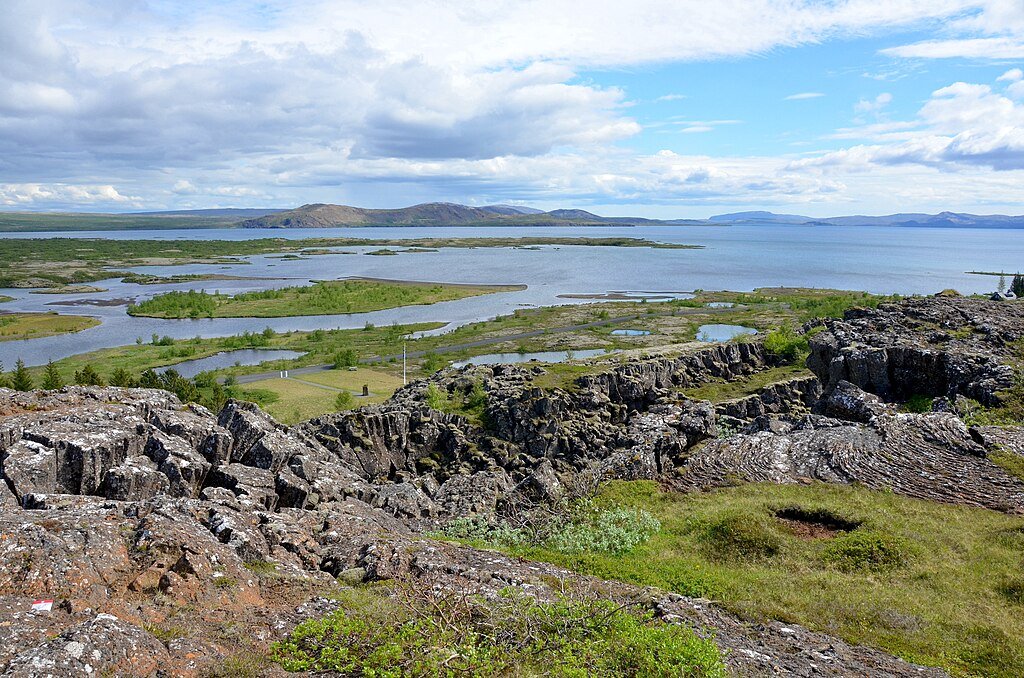
The Mid Atlantic Ridge
From the Visitor’s Center with its viewpoint, the walking trail leads though the most obvious section of the Mid Atlantic Ridge. The actual name is Almannagjá, or the ‘all man’s gorge’, and is essentially the edge of the North American tectonic plate.
Following this walking path takes you past several points of historical significance to the Öxarárfoss Waterfall.
Thingvallabær & Thingvellir Church
To the east of the Almannagjá is Thingvallabær, a tribute to the farmhouses of old created and the official summer residence of Iceland’s prime minster. Next door is the Thingvellir Church, constructed in 1859 on the same spot where the original church was built when Iceland adopted Christianity.
Here, you can also see Iceland’s national graveyard, encircled by lava, the final resting place for some of Iceland’s national heroes.
Silfra Fissure
Southwest of Thingvallabær is the Silfra Fissure, located near the tip of the lake. This fissure lets visitors dive or snorkel in the Mid Atlantic Ridge – an awesome experience.
The shores of Lake Thingvallavatn
Far fewer visitors will explore the shores of Lake Thingvallavatn in the National Park. Road 361 from the Silfra area branches off across the northern shore, offering access to scenic viewpoints over the water and walking trails.
North of the Service Center
By far the least-visited area of Thingvellir National Park is the huge swathe of territory to the north of the main service center.
What to see and do in the park
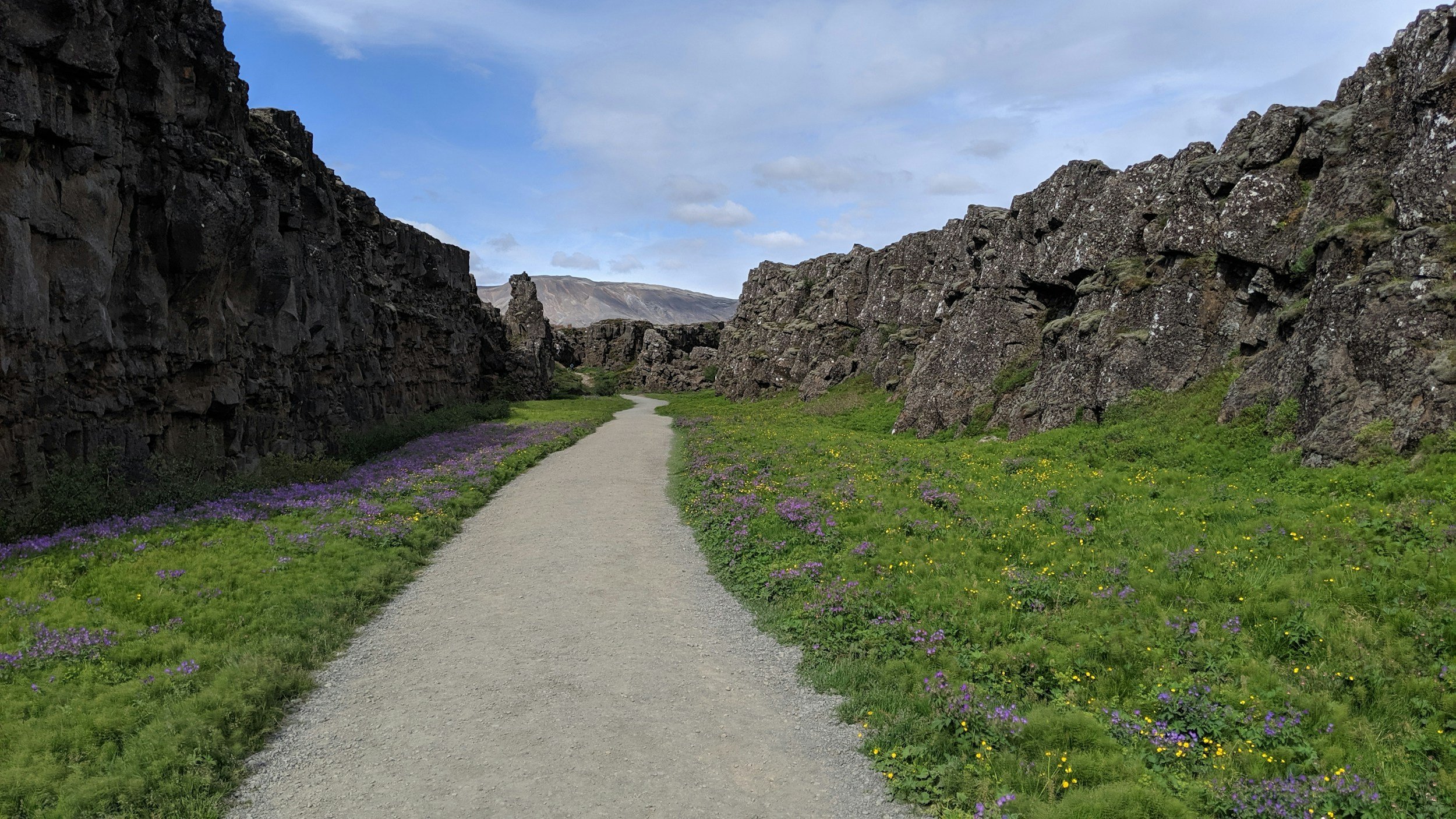


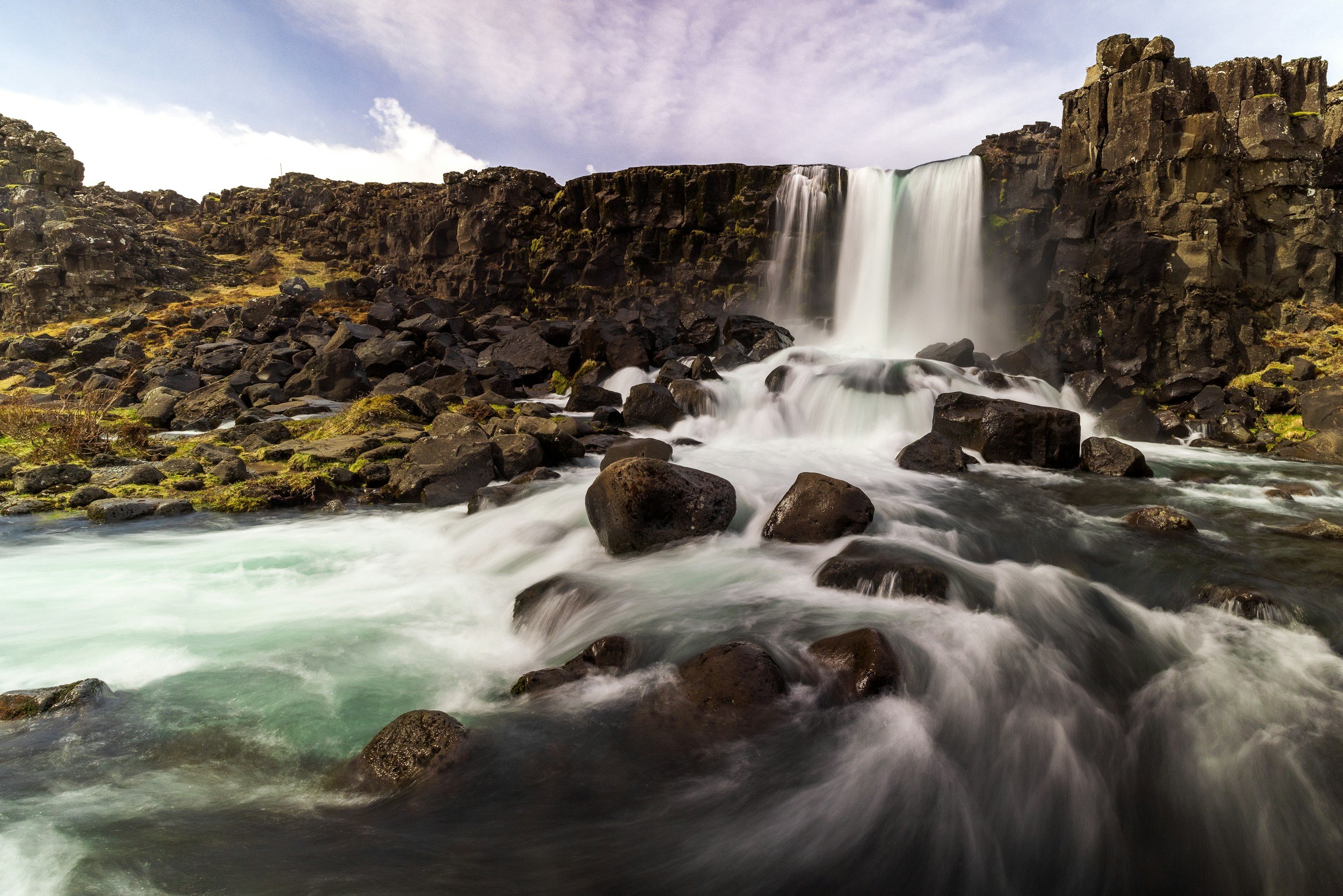



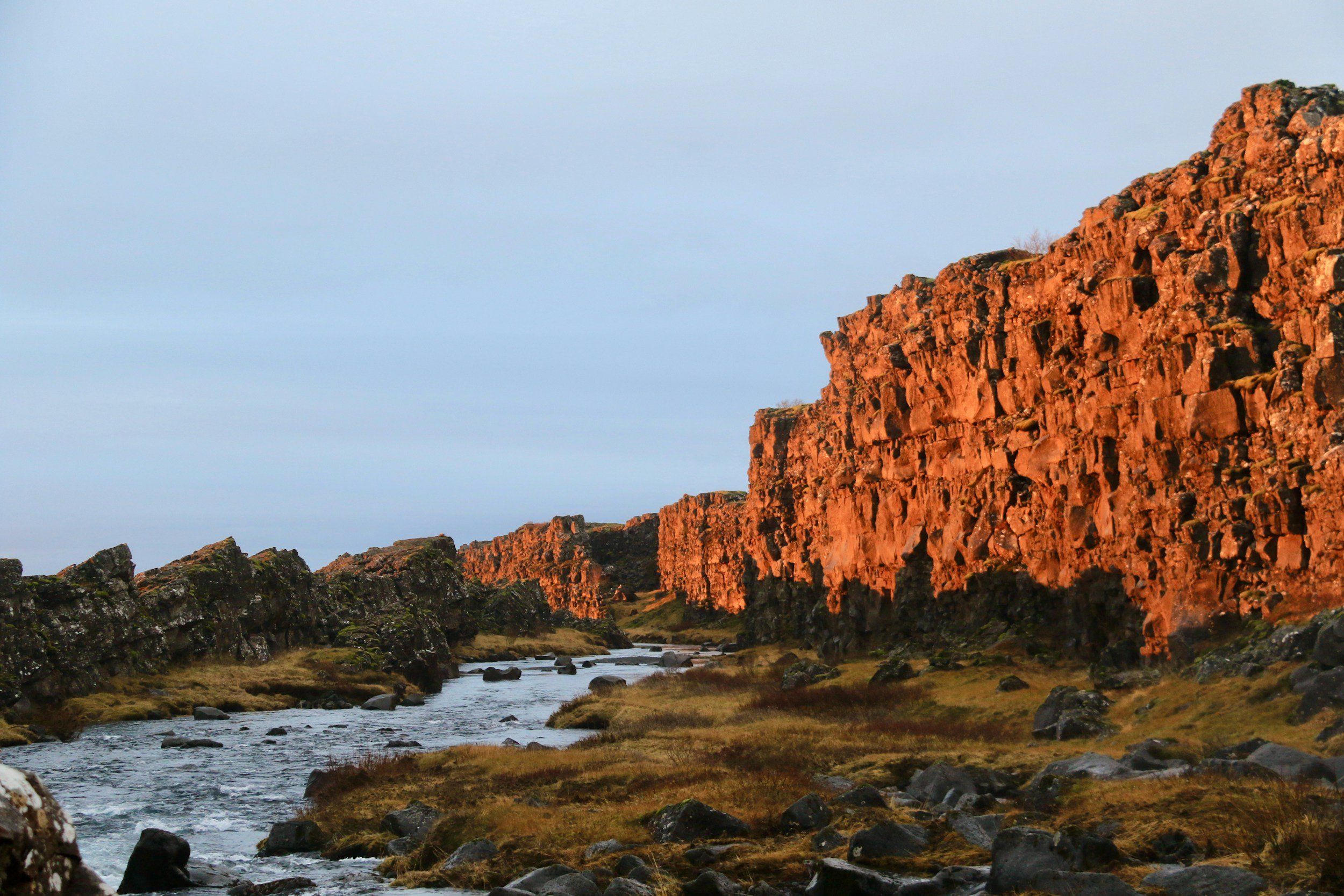
1. Visit the Heart of Iceland exhibition
The Heart of Iceland exhibition is a permanent installation at the Thingvellir Visitor Centre, offering an in-depth look into the geological, cultural, and historical significance of the park.
Visitors can explore interactive displays that detail the tectonic forces at work in the Mid-Atlantic Ridge as well as the historical events that took place at Thingvellir, including the establishment of the Althing, Iceland’s parliament. The exhibition also highlights the unique flora and fauna of the region.
2. Catch the views from the Hakið Observation Deck
The Hakið observation deck at Thingvellir National Park provides panoramic views of the park's dramatic landscape and has historically been the first introduction visiting friends and family get to Icelandic landscapes when I’ve taken them out to explore.
From here, you can see the expansive rift valley formed by the North American and Eurasian tectonic plates, inching apart further every year. You can also enjoy views over the serene lake, bordered by low-rising hills and mountains. Winter or summer, it’s a great starting point.
3. Walk through the Tectonic Divide
One of the most unique experiences at Thingvellir National Park is the opportunity to walk between two continental plates. The Almannagjá fault is a massive rift that marks the boundary between the North American and Eurasian plates, a dramatic fissure that a walking trail goes right through.
It’s well marked and easy-going and leads to several historical sites (below) within the national park.
4. The Law Rock, the Drowning Pool, and Öxarárfoss
Without context, you might just wander right by both the Law Rock and the Drowning Pool. The Law Rock (Lögberg) is a historic site where Icelandic chieftains once gathered for the Althing, the national assembly. Safe to say, it’s a place that holds great cultural significance, although there’s nothing much of note to look at other than the Icelandic flag fluttering in the strong winds.
Nearby, the Drowning Pool (Drekkingarhylur) is more scenic, until you read on the sign that this is where women were drowned as punishment for various crimes.
Things become more scenic still upon reaching Öxarárfoss, a waterfall fed by the Öxará River, although it pales in comparison to others in Iceland. Still, it has always served as a good setup for visiting friends, who are impressed and then completely unprepared for the thundering Gullfoss Waterfall further northeast.
5. Snorkel or dive at Silfra
Silfra Fissure is a world-renowned diving and snorkeling site located within Thingvellir National Park. The clear, glacial water in Silfra fissure offers visibility of up to 100 meters, providing an unparalleled underwater experience.
Fed from underneath a giant lava field, it’s some of the purest water in the world – where else can you take off your mask for a deep gulp of water before continuing? The water temperature remains around 2-4°C year-round, so a dry suit is necessary for comfort – although they’re not comfortable to get on in the first place.
6. Stop by the National Church and graveyard
I must admit, this is my least favorite part of the national park. The Thingvellir Church (Thingvallakirkja) and its adjoining graveyard are small but historically significant sites, but unless you’re particularly into churches, it’s nothing special.
The graveyard surrounding the church is the final resting place of several notable Icelanders, including some early settlers.
7. Go fishing on Lake Thingvallavatn
Thingvellir National Park is home to Lake Thingvallavatn, Iceland’s largest natural lake. The lake is renowned for its clear waters and abundant fish, including Arctic char and brown trout. Boats aren’t allowed on the lake, but you can purchase both fly fishing and angling permits from the park’s Visitor Center.
It’s a nice way to spend some extended time in the area rather than just give it the cursory glance so many people do, of which I am also guilty.
8. Hike to the historical farm ruins
It’s not widespread knowledge, but Thingvellir National Park is also home to several ruins of farms. Trails meander through the flat lava fields, with bumpy knolls rising here and there and open rock fissures on all sides.
On the valley floor north of the lake you’ll likely find yourself at Skógarkot, although there’s not much left to look at. Hrauntún is another farm ruin about 30 to 45 minutes northeast, which means you need to cross over Route 36 and venture pleasantly far from the main area.
Vatnskot ruins are on the northern shores of the lake, about 15 minutes from the Silfra Fissure.
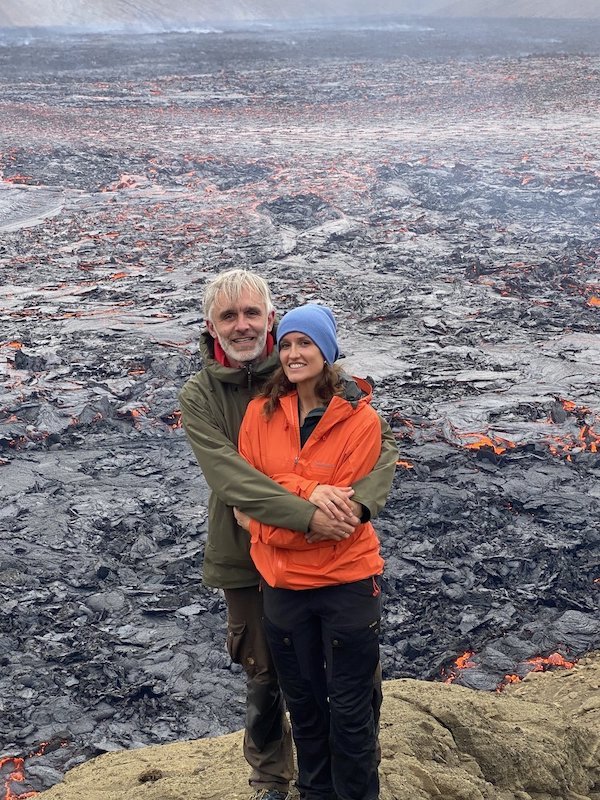

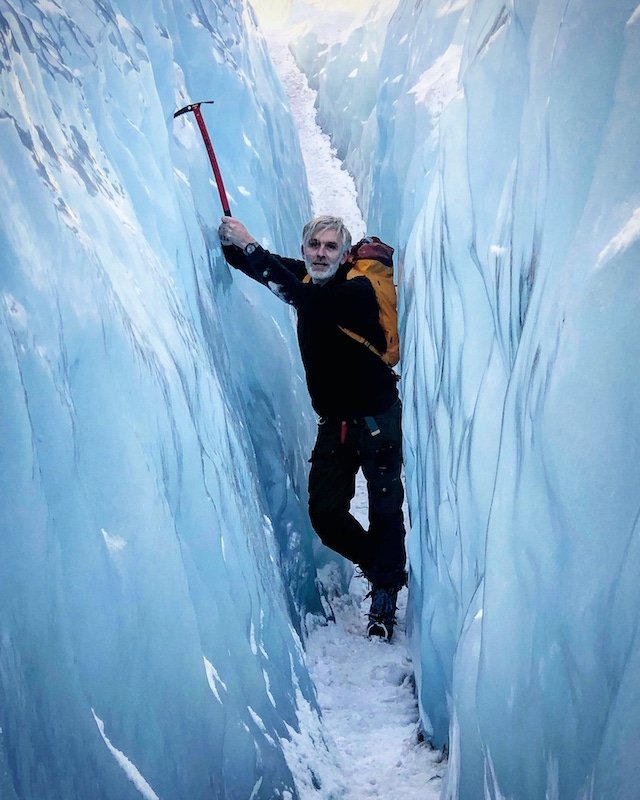


Connect with an Iceland expert!






